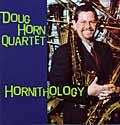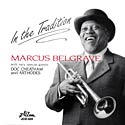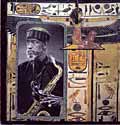| |


I N - T H I S - I S S U E :
 


|
|
Recent Recordings by Area Musicians
BY PIOTR MICHALOWSKI
Saxophonist
Doug Horn has been a regular on the Ann Arbor music scene for many
years, playing often in local restaurants and clubs, teaching in the public
schools and occasionally doing repair magic on instruments brought in
by locals as well as by traveling musicians. Horn is an unabashed be-bopper,
and he openly worships Phil Woods. Indeed, his debut CD  Hornithology
(BOPO 015)
opens with an original tribute to the great alto man entitled "Phil
in the Gap." The leader opens up from the very first moment, featuring
the alto sax, his main horn. His tone is bright and open and he phrases
like a veteran bopper, contrasting longer tones with flawlessly executed
double time passages and throwing in a quote from "Melancholy Baby."
His cohorts, Terry Lower on piano, Paul Keller on bass, and Sean Dobbins
on drums follow with their own flowing, idiomatic solos. The rest of the
album follows suit; this is relaxed modern jazz with a nice edge, performed
by a quartet of experienced craftsmen who play for the music and not for
effect. More than half the tunes are originals by Horn, who mostly sticks
to alto here. On two ballads "The Very Thought of You" and "Blame
it on my Youth" he opens up his warm big toned tenor sound, and pulls
out the bigger horn again for a fast romp through "I Want to be Happy."
For many saxophonists the flute is a secondary horn, required on some
gigs, but rarely mastered. To hear Horn play flute here, you would never
know he was a "doubler;" his tone is full and his articulation
shines. Anyone who has heard Horn play knows that he has an amazing technique
and can often burn wildly. He does push the music here, but never overwhelms,
and if anything he often understates, using his expert control to make
subtle musical points. Hornithology
(BOPO 015)
opens with an original tribute to the great alto man entitled "Phil
in the Gap." The leader opens up from the very first moment, featuring
the alto sax, his main horn. His tone is bright and open and he phrases
like a veteran bopper, contrasting longer tones with flawlessly executed
double time passages and throwing in a quote from "Melancholy Baby."
His cohorts, Terry Lower on piano, Paul Keller on bass, and Sean Dobbins
on drums follow with their own flowing, idiomatic solos. The rest of the
album follows suit; this is relaxed modern jazz with a nice edge, performed
by a quartet of experienced craftsmen who play for the music and not for
effect. More than half the tunes are originals by Horn, who mostly sticks
to alto here. On two ballads "The Very Thought of You" and "Blame
it on my Youth" he opens up his warm big toned tenor sound, and pulls
out the bigger horn again for a fast romp through "I Want to be Happy."
For many saxophonists the flute is a secondary horn, required on some
gigs, but rarely mastered. To hear Horn play flute here, you would never
know he was a "doubler;" his tone is full and his articulation
shines. Anyone who has heard Horn play knows that he has an amazing technique
and can often burn wildly. He does push the music here, but never overwhelms,
and if anything he often understates, using his expert control to make
subtle musical points.
Over
the years Hugh Leal has brought some of the finest traditional jazz players
to Windsor and featured them in concerts together with Michigan players.
 His
many recordings of these gigs have been taken over by the New Orleans
Jazzology label; among their recent offerings there is a gem featuring
trumpeter Marcus Belgrave in tandem with pianist Art Hodes and
fellow trumpeter Doc Cheatham (Marcus Belgrave, In the Tradition
(Jazzology JCD-324). The five duets
with Hodes, recorded almost two decades ago, show Belgrave at his best;
with no other instrumental support he is able to demonstrate the full
range of his trumpet skills, swinging and swaggering with his heart on
his sleeve. Hodes had a great left hand and there was absolutely no need
for bass and drums. Three tunes recorded in 1995 find Belgrave in the
company of another trumpet master, the late Doc Cheatham, who also sings
in his own inimitable manner, with lovely obligatos by Belgrave. They
trade choruses and chase each other with spirit and verve and it is hard
to imagine that Cheatham was 90 years old when these sides were recorded.
James Dapogny strides mightily on the piano, and Paul Keller on bass,
as well as Pete Siers on drums offer strong, idiomatic support. The disk
is rounded out with two tracks on which saxophonist Charlie Gabriel and
pianist Claude Black replace Cheatham and Dapogny. Cheatham and Hodes
are now gone and this is a small reminder of their highly individualistic
contributions to 20th century music, but Belgrave is alive and well, and
has few rivals on his horn. Whether strutting through "Sweet Georgia
Brown" or gently intoning "A Ghost of a Chance" he offers
a perfect balance of tradition and modernity, technique and soul, as well
as sheer musicality that is his alone. His
many recordings of these gigs have been taken over by the New Orleans
Jazzology label; among their recent offerings there is a gem featuring
trumpeter Marcus Belgrave in tandem with pianist Art Hodes and
fellow trumpeter Doc Cheatham (Marcus Belgrave, In the Tradition
(Jazzology JCD-324). The five duets
with Hodes, recorded almost two decades ago, show Belgrave at his best;
with no other instrumental support he is able to demonstrate the full
range of his trumpet skills, swinging and swaggering with his heart on
his sleeve. Hodes had a great left hand and there was absolutely no need
for bass and drums. Three tunes recorded in 1995 find Belgrave in the
company of another trumpet master, the late Doc Cheatham, who also sings
in his own inimitable manner, with lovely obligatos by Belgrave. They
trade choruses and chase each other with spirit and verve and it is hard
to imagine that Cheatham was 90 years old when these sides were recorded.
James Dapogny strides mightily on the piano, and Paul Keller on bass,
as well as Pete Siers on drums offer strong, idiomatic support. The disk
is rounded out with two tracks on which saxophonist Charlie Gabriel and
pianist Claude Black replace Cheatham and Dapogny. Cheatham and Hodes
are now gone and this is a small reminder of their highly individualistic
contributions to 20th century music, but Belgrave is alive and well, and
has few rivals on his horn. Whether strutting through "Sweet Georgia
Brown" or gently intoning "A Ghost of a Chance" he offers
a perfect balance of tradition and modernity, technique and soul, as well
as sheer musicality that is his alone.
The
Northwoods Improvisers have been pursuing their own singular musical
vision for many years, but in recent times their work has been changing.
On their latest release they are joined by tenor and alto  saxophonist
Faruq Z. Bey, invoking Griot Galaxy and the heyday of Detroit new
music (Faruq Z. Bey with the Northwoods Improvisers, 19 Moons,
Entropy Stereo). The regular
Northwoods trio of Mike Gilmore (vibes, bone guitar), Mike Johnston (bass),
and Nick Ashoton (drums) stretch their musical horizons here, working
into drones and grooves as Bey intones and preaches on his singing saxophones.
Bey's musical roots lie in the sixties and his sax playing is very much
the late-Coltrane or Pharoah Sanders incantatory mode and it works very
well against the more abstract backgrounds provided by the trio. The result
is an infectious, highly spiritual music. On two tracks Leo Bukowski joins
the foursome on the contra-alto clarinet, providing effective deep drones,
and on "Fountain"
they are augmented by the tambura of Patrick Boyer. saxophonist
Faruq Z. Bey, invoking Griot Galaxy and the heyday of Detroit new
music (Faruq Z. Bey with the Northwoods Improvisers, 19 Moons,
Entropy Stereo). The regular
Northwoods trio of Mike Gilmore (vibes, bone guitar), Mike Johnston (bass),
and Nick Ashoton (drums) stretch their musical horizons here, working
into drones and grooves as Bey intones and preaches on his singing saxophones.
Bey's musical roots lie in the sixties and his sax playing is very much
the late-Coltrane or Pharoah Sanders incantatory mode and it works very
well against the more abstract backgrounds provided by the trio. The result
is an infectious, highly spiritual music. On two tracks Leo Bukowski joins
the foursome on the contra-alto clarinet, providing effective deep drones,
and on "Fountain"
they are augmented by the tambura of Patrick Boyer.
I N - T H I S - I S S U E :
1. RECENT
RECORDINGS 2. McCRAY MEMORIAL
3. JANE BUNNETT
-HOME
|
|

